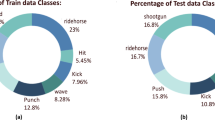Abstract
Violence against women captured in videos and surveillance systems necessitates effective identification to enable appropriate reactions for controlling and mitigating of its effects in public spaces and the potential apprehension of aggressors. While several algorithms have been developed for violence detection, their evaluation has primarily focused on controlled scenarios with clear differentiation between violent and non-violent scenes, representing two-class identification problems. However, real-world situations often present challenges where specific actions, such as hugs or effusive greetings, fall into an ambiguous class that is difficult to classify. Consequently, this transforms into a multi-class identification problem. In this study, we assess the performance of three pre-trained models, namely VGG16, ResNet50, and InceptionV3, to evaluate their efficacy in addressing the multi-class identification challenges. Furthermore, we compare their performance against datasets consisting of two-class classifications, where the models generally exhibit satisfactory results. Our analysis reveals that the models struggle to differentiate the ambiguous scenes effectively, with Inception V3 achieving a 0% correct detection rate for this class. Notably, VGG16 outperforms the other models, attaining accurate detections of 48% for the ambiguous class, 75% for non-violence scenes, and 54% for violence scenes. This research sheds light on the limitations of current classification models when confronted with the complexity of real-world scenarios. The findings emphasize the importance of developing improved algorithms capable of accurately distinguishing ambiguous situations and enhancing the performance of violence detection systems.
TecNM has partially supported this investigation with project 13816.22-P.
Access this chapter
Tax calculation will be finalised at checkout
Purchases are for personal use only
Similar content being viewed by others
References
INEGI. Violencia contra las mujeres en méxico (2022). https://www.inegi.org.mx/tablerosestadisticos/vcmm/
Moctezuma-Navarro, D., Narro-Robles, J., Orozco-Hernandez, L.: La mujer en méxico: inequidad, pobreza y violencia. Rev. mex. cienc. polít. soc 117–146 (2014)
Suárez Páez, J.E.: Arquitectura de detección de actividades criminales basada en análisis de vídeo en tiempo real. PhD thesis, Universitat Politècnica de València (2020)
Bisbé, E.L.: Detección de escenas de violencia con modelos deep learning. B.S. thesis, Universidad Autonoma de Madrid (2020)
Victor, E.D.S., Lacerda, T.B., Miranda, P.B.C., Nascimento, A.C.A., Furtado, A.P.C.: Federated learning for physical violence detection in videos. In: 2022 International Joint Conference on Neural Networks (IJCNN), pp. 1–8. IEEE (2022)
Min Ullah, F.U., Ullah, A., Muhammad, K., Ul Haq, I., Baik, S.W.: Violence detection using spatiotemporal features with 3D convolutional neural network. Sensors 19(11), 2472 (2019)
Powell González, J.E., et al.: Detección de peleas en videos usando estimación de postura y bi-lstm. Master’s thesis, Benemérita Universidad Autónoma de Puebla (2021)
Rodriguez, P.S.: Reconocimiento de expresiones faciales mediante el uso de redes neuronales convolucionales. B.S. thesis, Universitat Politécnica de Catalunya (2017)
Sánchez, J., Campos, M.A.: Red neuronal artificial para detección de armas de fuego y armas blancas en video vigilancia. Revista de Iniciación Científica 7(2), 83–88 (2021)
Jiang, B., Xu, F., Tu, W., Yang, C.: Channel-wise attention in 3d convolutional networks for violence detection. In: 2019 International Conference on Intelligent Computing and its Emerging Applications (ICEA), pp. 59–64. IEEE (2019)
El Kaid, A., Baına, K., Baına, J.: Reduce false positive alerts for elderly person fall video-detection algorithm by convolutional neural network model. Procedia Comput. Sci. 148, 2–11 (2019)
Datta, A., Shah, M., Da Vitoria Lobo, N.: Person-on-person violence detection in video data. In: 2002 International Conference on Pattern Recognition, vol. 1, pp. 433–438. IEEE (2002)
Vosta, S., Yow, K.-C.: A CNN-RNN combined structure for real-world violence detection in surveillance cameras. Appl. Sci. 12(3), 1021 (2022)
LeCun, Y., Bengio, Y., Hinton, G.: Deep learning. Nature 521(7553), 436–444 (2015)
Goodfellow, I., Bengio, Y., Courville, A.: Deep Learning. MIT Press, Cambridge (2016)
Yu, Y., Si, X., Hu, C., Zhang, J.: A review of recurrent neural networks: LSTM cells and network architectures. Neural Comput. 31(7), 1235–1270 (2019)
Bengfort, B., Bilbro, R., Ojeda, T.: Applied Text Analysis with Python. O’Reilly Media Inc. (2018)
Zhao, R., Yan, R., Wang, J., Mao, K.: Learning to monitor machine health with convolutional bi-directional LSTM networks. Sensors 17(2) (2017)
Wu, J.-L., He, Y., Yu, L.-C., Robert Lai, K.: Identifying emotion labels from psychiatric social texts using a bi-directional LSTM-CNN model. IEEE Access 8, 66638–66646 (2020)
Kattenborn, T., Leitloff, J., Schiefer, F., Hinz, S.: Review on convolutional neural networks (CNN) in vegetation remote sensing. ISPRS J. Photogramm. Remote. Sens. 173, 24–49 (2021)
Yang, H., Ni, J., Gao, J., Han, Z., Luan, T.: A novel method for peanut variety identification and classification by improved VGG16. Sci. Rep. 11, 15756 (2021)
Theckedath, D., Sedamkar, R.R.: Detecting affect states using VGG16, ResNet50 and SE-ResNet50 networks. SN Comput. Sci. 1(2), 1–7 (2020)
Szegedy, C., Vanhoucke, V., Ioffe, S., Shlens, J., Wojna, Z.: Rethinking the inception architecture for computer vision. In: 2016 IEEE Conference on Computer Vision and Pattern Recognition (CVPR), pp. 2818–2826 (2016)
Bianculli, M., et al.: A dataset for automatic violence detection in videos. Data Brief 33, 106587 (2020)
Bradski, G.: The OpenCV library. Dr. Dobbś J.: Softw. Tools Prof. Program. 25, 120–123 (2000)
Luque, A., Carrasco, A., Martin, A., De-Las-Heras, A.: The impact of class imbalance in classification performance metrics based on the binary confusion matrix. Pattern Recogn. 91, 216–231 (2019)
Grandini, M., Bagli, E., Visani, G.: Metrics for multi-class classification: an overview (2020)
Author information
Authors and Affiliations
Corresponding author
Editor information
Editors and Affiliations
Rights and permissions
Copyright information
© 2024 The Author(s), under exclusive license to Springer Nature Singapore Pte Ltd.
About this paper
Cite this paper
Abundez, I., Miranda-Piña, G., Alejo, R., Granda-Gutiérrez, E.E., Cisniega, A., Portillo-Rodríguez, O. (2024). Empirical Analysis on the Effectiveness of Pre-trained Models in the Identification of Physical Violence Against Women in Videos for a Multi-class Approach. In: Tan, Y., Shi, Y. (eds) Data Mining and Big Data. DMBD 2023. Communications in Computer and Information Science, vol 2017. Springer, Singapore. https://doi.org/10.1007/978-981-97-0837-6_11
Download citation
DOI: https://doi.org/10.1007/978-981-97-0837-6_11
Published:
Publisher Name: Springer, Singapore
Print ISBN: 978-981-97-0836-9
Online ISBN: 978-981-97-0837-6
eBook Packages: Computer ScienceComputer Science (R0)




